ABS OPEL MOVANO_B 2018 Manual user
[x] Cancel search | Manufacturer: OPEL, Model Year: 2018, Model line: MOVANO_B, Model: OPEL MOVANO_B 2018Pages: 265, PDF Size: 6.39 MB
Page 86 of 265

84Instruments and controlsInstruments and
controlsControls ....................................... 85
Steering wheel adjustment ........85
Steering wheel controls .............85
Horn ........................................... 85
Steering column controls ...........85
Windscreen wiper/washer .........86
Outside temperature ..................87
Clock ......................................... 88
Power outlets ............................. 88
Cigarette lighter ......................... 90
Ashtrays .................................... 90
Warning lights, gauges and indi‐ cators ........................................... 90
Instrument cluster ......................90
Speedometer ............................. 90
Odometer .................................. 91
Trip odometer ............................ 91
Tachometer ............................... 91
Fuel gauge ................................ 92
AdBlue gauge ............................ 92
Engine coolant temperature gauge ....................................... 92
Engine oil level monitor .............93
Service display .......................... 93Transmission display .................94
Control indicators ......................94
Turn signal ................................. 97
Seat belt reminder .....................97
Airbag and belt tensioners .........97
Airbag deactivation ....................97
Charging system .......................98
Malfunction indicator light ..........98
Service vehicle soon .................98
Stop engine ............................... 99
Brake system ............................. 99
Antilock brake system (ABS) .....99
Upshift ....................................... 99
Lane departure warning ............99
Electronic Stability Program ....100
Electronic Stability Program off ........................................... 100
Engine coolant temperature ....100
Preheating ............................... 100
AdBlue ..................................... 100
Tyre pressure monitoring system .................................... 100
Engine oil pressure ..................101
Low fuel ................................... 101
Stop-start system ....................101
Exterior light ............................ 102
High beam ............................... 102
High beam assist .....................102
Fog light ................................... 102
Rear fog light ........................... 102Cruise control.......................... 102
Tachograph ............................. 102
Door open ................................ 102
Information displays ...................103
Driver Information Centre ........103
Info display .............................. 103
Vehicle messages ......................104
Warning chimes .......................104
Trip computer ............................. 105
Tachograph ................................ 107
Page 98 of 265
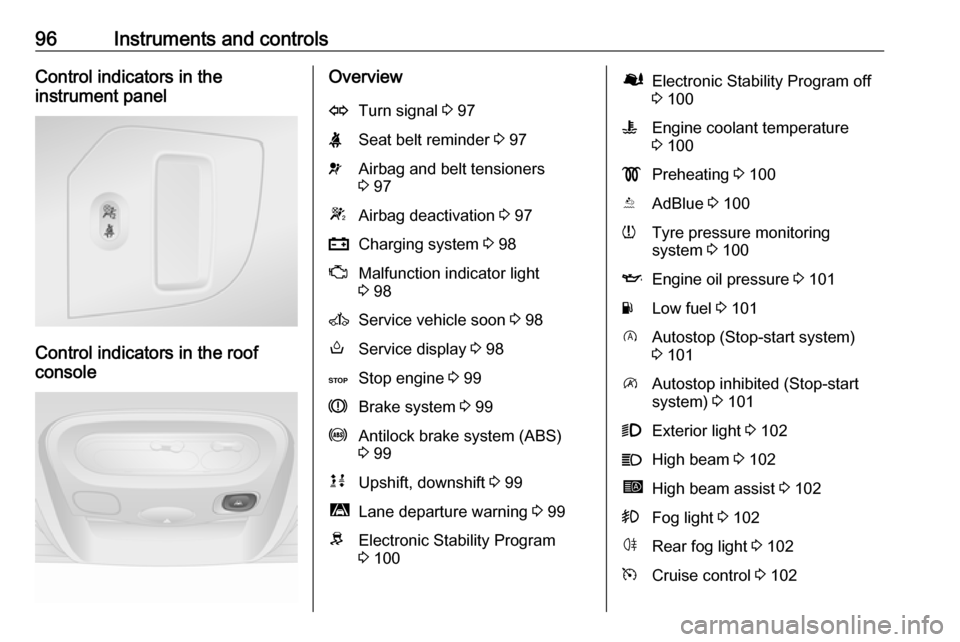
96Instruments and controlsControl indicators in the
instrument panel
Control indicators in the roof
console
OverviewOTurn signal 3 97XSeat belt reminder 3 97vAirbag and belt tensioners
3 97WAirbag deactivation 3 97pCharging system 3 98ZMalfunction indicator light
3 98AService vehicle soon 3 98oService display 3 98CStop engine 3 99RBrake system 3 99uAntilock brake system (ABS)
3 99kjUpshift, downshift 3 99ìLane departure warning 3 99RElectronic Stability Program
3 100ØElectronic Stability Program off
3 100WEngine coolant temperature
3 100!Preheating 3 100YAdBlue 3 100wTyre pressure monitoring
system 3 100IEngine oil pressure 3 101YLow fuel 3 101DAutostop (Stop-start system)
3 101\Autostop inhibited (Stop-start
system) 3 1019Exterior light 3 102CHigh beam 3 102íHigh beam assist 3 102>Fog light 3 102øRear fog light 3 102mCruise control 3 102
Page 101 of 265
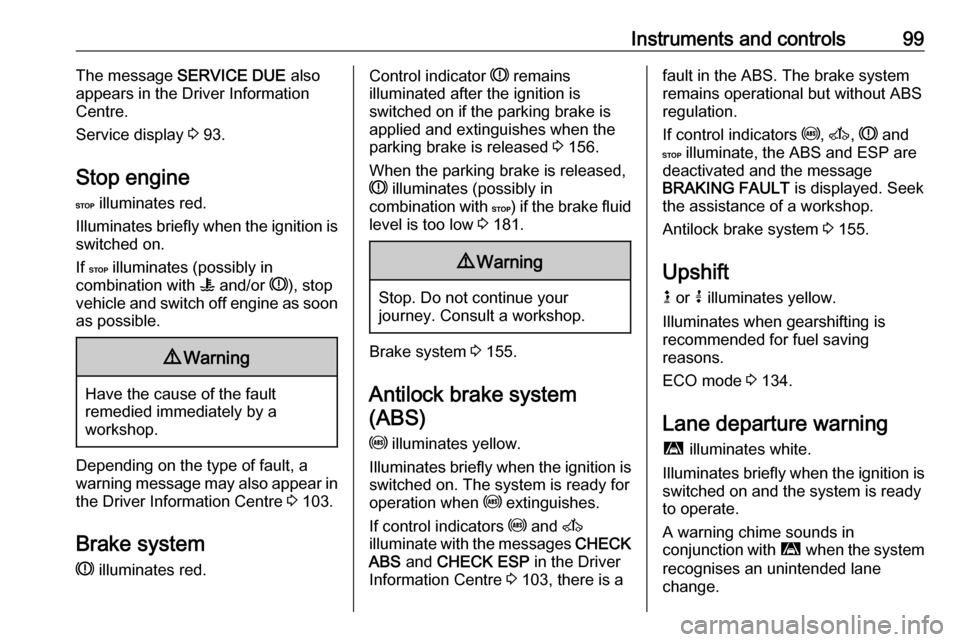
Instruments and controls99The message SERVICE DUE also
appears in the Driver Information
Centre.
Service display 3 93.
Stop engine
C illuminates red.
Illuminates briefly when the ignition is
switched on.
If C illuminates (possibly in
combination with W and/or R), stop
vehicle and switch off engine as soon as possible.9 Warning
Have the cause of the fault
remedied immediately by a
workshop.
Depending on the type of fault, a
warning message may also appear in the Driver Information Centre 3 103.
Brake system
R illuminates red.
Control indicator R remains
illuminated after the ignition is
switched on if the parking brake is
applied and extinguishes when the
parking brake is released 3 156.
When the parking brake is released, R illuminates (possibly in
combination with C) if the brake fluid
level is too low 3 181.9 Warning
Stop. Do not continue your
journey. Consult a workshop.
Brake system 3 155.
Antilock brake system (ABS)
u illuminates yellow.
Illuminates briefly when the ignition is
switched on. The system is ready for
operation when u extinguishes.
If control indicators u and A
illuminate with the messages CHECK
ABS and CHECK ESP in the Driver
Information Centre 3 103, there is a
fault in the ABS. The brake system
remains operational but without ABS
regulation.
If control indicators u, A , R and
C illuminate, the ABS and ESP are
deactivated and the message
BRAKING FAULT is displayed. Seek
the assistance of a workshop.
Antilock brake system 3 155.
Upshift
k or j illuminates yellow.
Illuminates when gearshifting is
recommended for fuel saving
reasons.
ECO mode 3 134.
Lane departure warning
ì illuminates white.
Illuminates briefly when the ignition is switched on and the system is ready
to operate.
A warning chime sounds in
conjunction with ì when the system
recognises an unintended lane
change.
Page 157 of 265

Driving and operating155Interruption of power supplyThe clutch is not disengaged if there
is an interruption of the power supply
when a gear is engaged. The vehicle
cannot move.
If the vehicle battery is discharged,
start the vehicle using jump leads
3 213.
If the cause of the fault is not a
discharged vehicle battery, seek the
assistance of a workshop.
If neutral cannot be selected, the
vehicle must only be towed with the
drive wheels raised off the ground
3 216.
Towing the vehicle 3 216.Brakes
The brake system comprises two
independent brake circuits.
If a brake circuit fails, the vehicle can
still be braked using the other brake
circuit. However, braking effect is
achieved only when you depress the
brake pedal firmly. You need to use
considerably more force for this. The
braking distance is extended. Seek
the assistance of a workshop before
continuing your journey.
When the engine is not running, the
support of the brake servo unit
disappears once the brake pedal has been depressed once or twice.
Braking effect is not reduced, but
braking requires significantly greater
force. It is especially important to bear this in mind when being towed.
Control indicator R 3 99.
Antilock brake system
Antilock brake system (ABS)
prevents the wheels from locking.ABS starts to regulate brake pressure as soon as a wheel shows a tendency
to lock. The vehicle remains
steerable, even during hard braking.
ABS control is made apparent
through a pulse in the brake pedal
and the noise of the regulation
process.
For optimum braking, keep the brake
pedal fully depressed throughout the
braking process, despite the fact that the pedal is pulsating. Do not reduce
the pressure on the pedal.
Control indicator u 3 99.
Fault
If control indicators u and A
illuminate with the messages CHECK
ABS and CHECK ESP in the Driver
Information Centre, there is a fault in
the ABS. The brake system remains
operational but without ABS
regulation.
Page 158 of 265
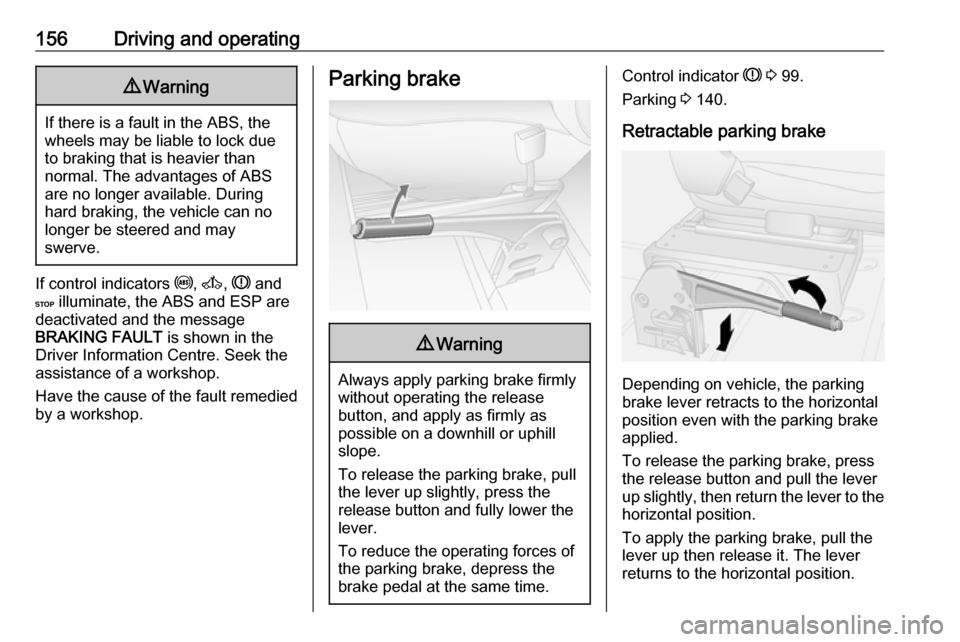
156Driving and operating9Warning
If there is a fault in the ABS, the
wheels may be liable to lock due
to braking that is heavier than
normal. The advantages of ABS are no longer available. During
hard braking, the vehicle can no longer be steered and may
swerve.
If control indicators u, A , R and
C illuminate, the ABS and ESP are
deactivated and the message
BRAKING FAULT is shown in the
Driver Information Centre. Seek the
assistance of a workshop.
Have the cause of the fault remedied
by a workshop.
Parking brake9 Warning
Always apply parking brake firmly
without operating the release
button, and apply as firmly as
possible on a downhill or uphill
slope.
To release the parking brake, pull
the lever up slightly, press the
release button and fully lower the
lever.
To reduce the operating forces of
the parking brake, depress the
brake pedal at the same time.
Control indicator R 3 99.
Parking 3 140.
Retractable parking brake
Depending on vehicle, the parking
brake lever retracts to the horizontal
position even with the parking brake
applied.
To release the parking brake, press the release button and pull the lever
up slightly, then return the lever to the
horizontal position.
To apply the parking brake, pull the
lever up then release it. The lever
returns to the horizontal position.
Page 198 of 265
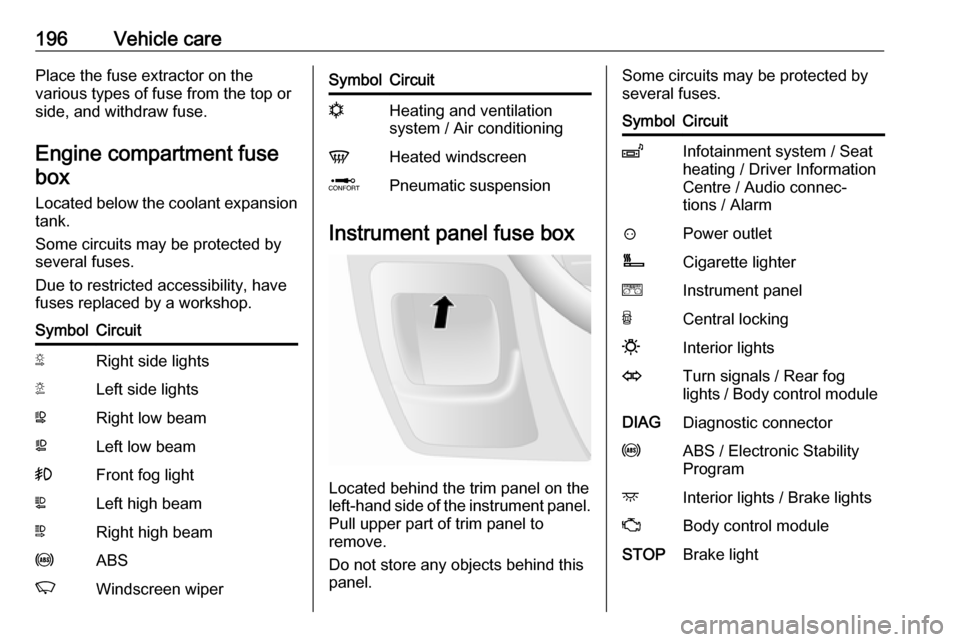
196Vehicle carePlace the fuse extractor on the
various types of fuse from the top or
side, and withdraw fuse.
Engine compartment fusebox
Located below the coolant expansion
tank.
Some circuits may be protected by
several fuses.
Due to restricted accessibility, have
fuses replaced by a workshop.SymbolCircuitSRight side lightsTLeft side lightsWRight low beamaLeft low beam>Front fog lightLLeft high beamNRight high beamuABSKWindscreen wiperSymbolCircuitnHeating and ventilation
system / Air conditioningVHeated windscreenQPneumatic suspension
Instrument panel fuse box
Located behind the trim panel on the
left-hand side of the instrument panel.
Pull upper part of trim panel to
remove.
Do not store any objects behind this
panel.
Some circuits may be protected by
several fuses.SymbolCircuitZInfotainment system / Seat
heating / Driver Information
Centre / Audio connec‐
tions / Alarm?Power outletÌCigarette lightereInstrument panelUCentral locking0Interior lightsOTurn signals / Rear fog
lights / Body control moduleDIAGDiagnostic connectoruABS / Electronic Stability
ProgramdInterior lights / Brake lightsZBody control moduleSTOPBrake light
Page 219 of 265
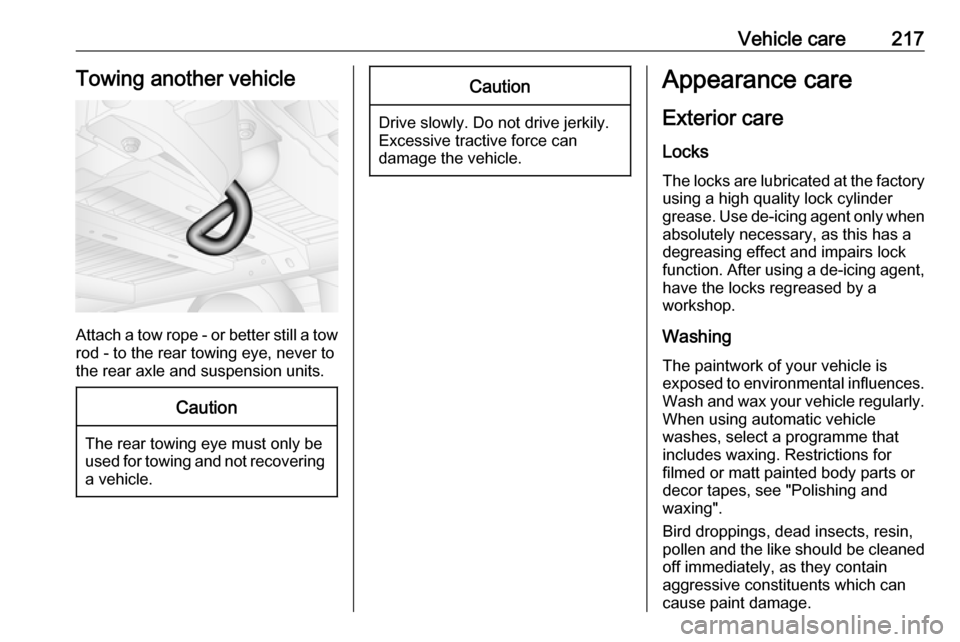
Vehicle care217Towing another vehicle
Attach a tow rope - or better still a tow
rod - to the rear towing eye, never to
the rear axle and suspension units.
Caution
The rear towing eye must only be
used for towing and not recovering a vehicle.
Caution
Drive slowly. Do not drive jerkily.
Excessive tractive force can
damage the vehicle.
Appearance care
Exterior care Locks
The locks are lubricated at the factory using a high quality lock cylinder
grease. Use de-icing agent only when absolutely necessary, as this has a
degreasing effect and impairs lock function. After using a de-icing agent,
have the locks regreased by a
workshop.
WashingThe paintwork of your vehicle is
exposed to environmental influences.
Wash and wax your vehicle regularly.
When using automatic vehicle
washes, select a programme that
includes waxing. Restrictions for
filmed or matt painted body parts or
decor tapes, see "Polishing and
waxing".
Bird droppings, dead insects, resin,
pollen and the like should be cleaned
off immediately, as they contain
aggressive constituents which can
cause paint damage.
Page 226 of 265
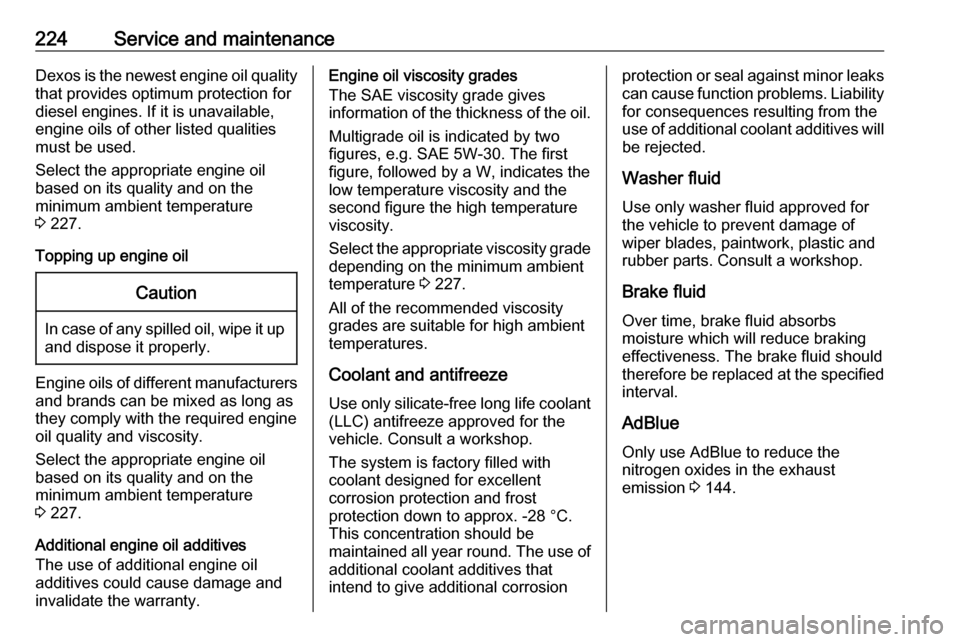
224Service and maintenanceDexos is the newest engine oil quality
that provides optimum protection for
diesel engines. If it is unavailable,
engine oils of other listed qualities
must be used.
Select the appropriate engine oil
based on its quality and on the
minimum ambient temperature
3 227.
Topping up engine oilCaution
In case of any spilled oil, wipe it up and dispose it properly.
Engine oils of different manufacturersand brands can be mixed as long as
they comply with the required engine
oil quality and viscosity.
Select the appropriate engine oil
based on its quality and on the
minimum ambient temperature
3 227.
Additional engine oil additives
The use of additional engine oil
additives could cause damage and
invalidate the warranty.
Engine oil viscosity grades
The SAE viscosity grade gives
information of the thickness of the oil.
Multigrade oil is indicated by two
figures, e.g. SAE 5W-30. The first figure, followed by a W, indicates the
low temperature viscosity and the
second figure the high temperature
viscosity.
Select the appropriate viscosity grade depending on the minimum ambient
temperature 3 227.
All of the recommended viscosity
grades are suitable for high ambient
temperatures.
Coolant and antifreeze
Use only silicate-free long life coolant
(LLC) antifreeze approved for the
vehicle. Consult a workshop.
The system is factory filled with
coolant designed for excellent
corrosion protection and frost
protection down to approx. -28 °C.
This concentration should be
maintained all year round. The use of additional coolant additives that
intend to give additional corrosionprotection or seal against minor leaks
can cause function problems. Liability
for consequences resulting from the
use of additional coolant additives will be rejected.
Washer fluid
Use only washer fluid approved for
the vehicle to prevent damage of wiper blades, paintwork, plastic and
rubber parts. Consult a workshop.
Brake fluid
Over time, brake fluid absorbs
moisture which will reduce braking
effectiveness. The brake fluid should therefore be replaced at the specified
interval.
AdBlue
Only use AdBlue to reduce the
nitrogen oxides in the exhaust
emission 3 144.
Page 258 of 265

256IndexAAbsorptive Glass Mat battery .....182
Accessories and vehicle modifications .......................... 176
Adaptive forward lighting ...112, 188
AdBlue ........................ 100, 144, 223
AdBlue gauge ............................... 92
AdBlue tank ................................ 246
Adjustable air vents ...................130
Airbag and belt tensioners ...........97
Airbag deactivation ................61, 97
Airbag label................................... 57 Airbag system .............................. 57
Air conditioning regular operation ................................ 131
Air conditioning system .............. 118
Air intake .................................... 131
Air suspension ........................... 141
Air suspension system................ 216
Air vents...................................... 130
Antifreeze ................................... 179
Antilock brake system ................ 155
Antilock brake system (ABS) .......99
Anti-theft alarm system ................34
Anti-theft bolts............................. 208
Anti-theft locking system .............. 34
Anti-theft security lock ..................23
Appearance care ........................217
Armrest ........................................ 49
Ashtrays ....................................... 90Automatic light control ...............109
Automatic locking ...................24, 27
Autostop ....................... 18, 136, 137
Auxiliary heater ........................... 124
B Battery ........................................ 182
Battery discharge protection ......116
Battery, jump starting.................. 213
Belts.............................................. 53
BlueInjection ............................... 144
Bonnet ....................................... 177
Bottle holders................................ 74 Brake assist ............................... 157
Brake fluid .......................... 181, 223
Brakes ............................... 155, 181
Brake system ............................... 99
Breakdown.................................. 216
Bulb replacement ....................... 185
Bus Rear seats ................................. 50
C Cabin bulkhead grille ....................80
Capacities .................................. 246
Cargo management system ........77
Car Pass ...................................... 21
Catalytic converter .....................143
Central locking system ................24
Centre high-mounted brake light 192
Changing tyre and wheel size ...204